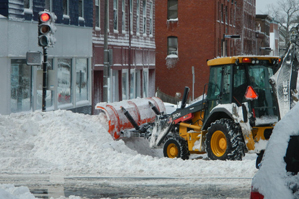Nemo and the inner workings of climate change models

After winter storm ‘Nemo’ dropped two feet of snow on us a couple weeks ago, it took the City of Boston two days to plow one of the roads leading to my home. The other was still buried beneath a thick, icy blanket for another day. The term “global warming” has been sitting on our lips for almost four decades, could it be the city no longer sees a need for plows in the age of climate change? If so, it should take a look at a 2011 study by Northeastern professor Auroop Ganguly and graduate student Evan Kodra.
Despite the overall warming trend in our climate, the 2011 paper suggests that cold snaps like the ones we’ve seen this winter (but were almost entirely absent here in New England last winter) will persist through the end of the century. I understand that climate is a long term version of the short term thing we call weather, but what I didn’t understand before an e-chat with Kodra was how exactly he and his colleagues are able to make meaningful statements about it. Below is a recap of what I learned in our “conversation.”
A wide range of experts all over the world have developed a series of climate change models that people like Kodra and Ganguly use to analyze the impacts of various climate change scenarios on the planet. The models are big computational algorithms of extreme complexity that integrate information about things like atmospheric circulation patterns, the shape of land masses and watersheds around the globe, mountain and vegetation coverage, and existing observational data, to name a few factors. The models break up the globe into a massive grid in which each parcel is treated as an individual unit, Kodra told me. “When the models run, they produce discrete values over the globe, and variables like temperature and rainfall are output at each rectangle for each time step,” he said. “Often the assumption is that these variables represent the average weather happening within that cell of the earth for that day.”
Evaluating climate models is a huge undertaking in its own right, said Kodra, whose work happens to be focused, in part, on that very thing. Two basic approaches look at the “skill” and “consensus” of various models, respectively. A “skillful” model is able to predict historical data with high accuracy. For instance, a prediction about the climate in 2011, based on earlier data, would check well against actual 2011 data. The consensus approach assumes that when multiple climate models, each of which uses a totally different set of data and algorithms, come up with the same results, those results are likely to be correct. A third approach “has tried to balance the two notions,” said Kodra. But, evaluating models has turned out to be an incredibly difficult task.
Additionally, the models seem to break down at the very local scale. “This gap is thought to be related to micro-scale physical processes that the community cannot represent well physically,” said Kodra. Also, the cells of the giant grid I mentioned above seem to be too big right now to get really detailed information about local environments. “Unfortunately, local decision makers usually need reliable predictions at these scales and find global predictions, where simulations are more realistic in the aggregate, less immediately relevant,” Kodra noted.
So where does this leave us? “It’s entirely possible that we could chalk Nemo up to natural variability that we have seeing for so long in New England, and in fact this is the most plausible explanation,” Kodra told me. But here’s the catch: The natural variability we’re all so used to in this part of the country is not always masked by the overall warming trend. “Hence, extremely cold weather will still pop up in the future,” he said. Some researchers are suggesting that warming taking place in one part of the world triggers cooling events in other regions. “Our personal view is that these remain hypotheses that need to be proven more rigorously for wider scientific acceptability.”
And this is generally where Ganguly and Kodra are headed. Since 2011 they have been exploring more deeply the hot and cold extremes that multiple climate models predict along with how those extremes will impact various sectors of society, from public health to the energy grid, Kodra said. He is also using his expertise as a statistician to compare the large datasets that come from climate models with large observational datasets. “The end goal is to build a succinct and reliable description of uncertainty in extremes that could eventually be helpful in decision making.”
Bottom line? Don’t get rid of the plows! We’re going to need them for a long time to come. But that doesn’t, by any means, negate the overall warming trend.







